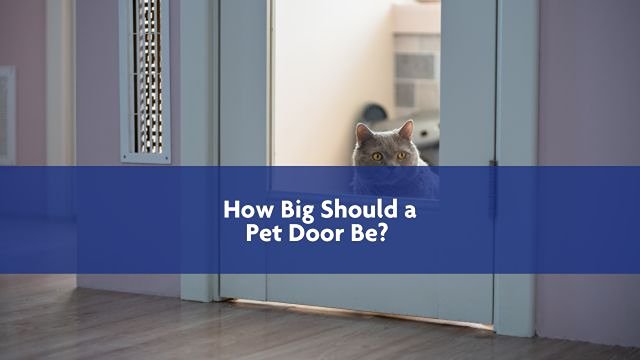

Posted October 21, 2025
Choosing the right pet door size is crucial for your furry friend's comfort and safety. A door that’s too small can make your cat or dog hesitant to use it, while one that’s too large can affect your home’s security and insulation.
This guide will help you find the right size pet door for your dog and cat, ensuring smooth sailing (or should we say, tail-wagging) for years to come.
Whether you're dealing with a tiny terrier or a gentle giant, getting the pet door installation right is key!
Imagine trying to squeeze through a doorway that's just a tad too small – not fun, right?
The same goes for your pets. An ill-fitting pet door can cause discomfort, hesitation, and even injury.
If the door opening is too low, your tallest pet will have to crouch, putting unnecessary strain on their joints. And if the flap size is too small, your doggy door becomes an obstacle course.
So, nailing the right dog door size or cat flap is about much more than just convenience; it's about your pet's well-being.
Choosing among “Small”, “Medium”, “Large” (and sometimes “Extra-Large”) can feel like deciphering a code. Generally, manufacturers express size in terms of the flap’s width and height, or the overall cut-out dimensions.
What counts most is your pet’s shoulder height, body width (chest or hips) and how much clearance they need. Because standards vary, don’t rely only on labels, always check the actual measurements.
Before you even think about installing the pet door, grab a measuring tape!
Start by measuring the height of your pet at the tallest point of your dog's back. This is crucial for determining the appropriate height of the bottom of the pet door for your pet.
A good rule of thumb is to choose a pet door where the top of the flap is at least as high as the point of your dog's back.
Many manufacturers provide a size chart that correlates your pet's measurements with the ideal pet door size. If in doubt, it’s usually better to go a size up to ensure comfortable passage, especially for large dogs or breeds with thick fur.
Start by measuring from the ground to the tallest point of your pet’s back, their shoulder blades (withers). This height determines how high the bottom of the pet door should sit once installed.
A flap that’s too high forces pets to jump; too low can cause drafts or awkward crouching. Aim for the top of the flap to align roughly with the top of your pet’s back.
Next, observe your pet walking naturally and measure their widest point, usually the chest or hips.
Add a few centimetres to this width so they can pass through comfortably without brushing the sides. For broad-shouldered dogs or fluffy cats, that extra space makes a big difference.
If the pet door will go through a wall or thick glass, ensure the tunnel depth allows easy passage. Many pet doors come with adjustable or extension tunnels, useful for glass, timber, or brick installations.
Cat doors range from simple flap models to advanced microchip pet doors that only open for your cat.
Choose a flap that’s soft-closing or magnetised for quieter use, and ensure the opening suits your cat’s height and build (see the Cat Door Size Guide below).
Dogs come in all shapes and sizes, from chihuahuas to retrievers. So the right fit matters.
Remember: a door that’s too large can affect insulation, while one too small may deter use.
Pet doors can be integrated neatly into sliding glass doors using glass inserts or replacement panels.
Sharp Glass can customise and install these, ensuring the new glass meets NZ glazing standards and remains secure and energy-efficient. This is especially important for double-glazed units, where professional installation protects the seal integrity.
When installing through other materials, consider:
For glass doors, always consult a professional glazier to avoid cracking or weakening the panel.
Before starting your pet door installation, take a few minutes to prepare the space properly.
Check the area for any obstructions, hidden wiring, or framing that might interfere with cutting or fitting. Mark the correct flap height using your pet’s shoulder measurement to ensure an easy, natural entry.
If you’re installing into glass, confirm that the panel is toughened or safety-rated before any cutting begins. This is essential for maintaining structural integrity and compliance with glazing standards.
Once installed, test that the flap swings smoothly, the frame is tightly sealed against drafts, and any locks or sliding mechanisms still operate as intended.
A properly fitted pet door not only prevents rattling and air leaks but also keeps your home secure and your pets confident using their new entryway.
Pet door installation can look straightforward, but if you’re working with glass, double glazing, or sliding doors, professional help makes all the difference.
Glass requires precise cutting and sealing to maintain strength, insulation, and safety standards. A glazier can ensure your new pet door fits perfectly and performs as intended.
Sharp Glass, based in Christchurch, specialises in installing pet doors into a variety of glass panels and frames, delivering a clean, secure, and weather-tight finish that meets New Zealand safety requirements.
Seriously, a properly installed pet door is an investment in both convenience and peace of mind.
